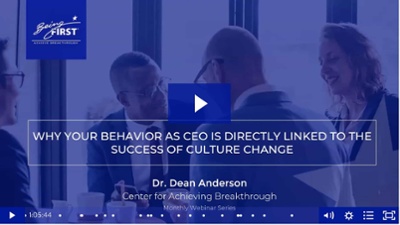Major change in an organization, especially transformational change, demands that people change personally—how they think, how they behave, and how they alter their ways of working that the transformation requires to sustain its value to the business. Executives must understand the leadership behaviors required of them. Stakeholders will look to the executives to see, or more likely to test, if the change is real for their leaders. So, the first person who must demonstrate the validity of the change is you, as CEO!
Modeling the Change: A Necessary Leadership Quality
Senior leaders often hold the faulty assumption that personal work isn’t required of them for an organizational change initiative to succeed or that they can delegate responsibility for their change efforts to others and just get progress reports. This may be true if the current mindsets and behavior in your organization are adequate to drive the new state, or if you are making a change that truly does not require much human or cultural change. Most of today's change efforts, however, do require significant changes in mindset and behavior to succeed. If this is the case in your organization, as CEO you must model the new behavior and mindset first. We call this “walking the talk” and it is the most crucial of all leadership qualities.
How Do You Know if Leadership Modeling Is Required?
Leadership modeling is paramount to your success if your changes are significant enough to demand shifts in behavior, mindset, culture, relationships, language, or any other aspect of how people work with each other. New desired behaviors may include greater teamwork, more sharing of information and power across boundaries or levels, more effective leadership styles, or increased risk-taking.
To begin to see the extent to which leadership modeling is required, ask yourself the following questions:
- If we continue to operate and think in the same ways we do today, will we be able to achieve the new reality we need here?
- Will we need new mindsets or behaviors in our organization to succeed in our new state?
- What are the new behaviors and mindsets required? Are they different for different levels or stakeholder groups?
- How well do I currently model these new behaviors and mindsets?
- What do I risk as a leader if I continue to act in the old ways in our change effort? How will the stakeholders who must make this change perceive me?
Watch Related Video: The Fundamental Shift Required in CEOs to Lead Transformation
How Does Leadership Modeling Work?
Some change efforts attempt to mandate changes in people from the outside in, through strategies like threat of job loss, new performance standards driven by rewards or ratings, or mandated training and testing. While these tactics have their place, they are not sufficient to sustain change in people. All personal change comes from the inside out. Change efforts only succeed over time if people choose to change. Otherwise, they may alter their behavior for a short while, and then revert to their old patterns or look for work-arounds. Personal change only sticks to the degree that people choose and commit to the change—for themselves. They need to see the value or relevance of making personal change, or be inspired to do so in positive ways. That’s where your modeling as the CEO comes into play.
When you model the new behaviors required for success, you create a safe environment for managers and employees to change. You raise people's willingness to choose the new direction, minimize resistance, and maximize buy-in and commitment. Employees look to you for the support—and the precedent—to change personally. If they see you changing, they will be much more likely to change.
What if You Fail to Model the Change Effectively?
The failure to identify your own need to make personal changes when you are leading change, has consequences. Even if you do not intend to ignore or not pursue required personal change, if you communicate one thing to those who must change and then do another, or repeatedly model the old way while advocating the new, you will lose credibility. Employees will be more reluctant to take a risk or invest in the new behaviors. They won’t believe them to be necessary. Resistance and cynicism may mushroom, which can be a major factor in your effort's failure.
How Do You Succeed at Modeling the Change?
To model the changes needed in your organization, you will first need to understand what they are. Take your most pressing transformational change and explore—ideally with your change leadership team—the mindsets, behaviors, relationships, and norms that must be changed for you to collectively achieve the outcome you require. Then evaluate yourself to identify how well you understand and already embody these personal changes, and what changes you need to make to more overtly embrace them. An executive coach or experienced consultant can assist in this process and may also be invaluable support as you implement these changes. Have your executives and leaders do the same, and ensure that the actions required are fully integrated into your transformational plans.
To support this process, ask yourself these mindful questions:
- How will achieving and sustaining the future state affect me personally— my role, priorities, ways of working, my motivations, fears and hopes?
- How do I want my team and workforce to see me as a sponsor or leader of the change?
- How do I need to think and act differently to ensure the success of the change during its design, implementation, and over time?
- What behaviors do I need other leaders and sponsors of this change to demonstrate? How do I need them to think differently than they do today?
Examples of Personal and Leadership Style Changes
Here are some examples of the type of modeling you might require:
- If your organizational transformation requires a collaborative culture, you and your team must work collaboratively. Provide fewer answers and ask more questions. Get more people involved, and keep those not involved informed. Ask for others’ input in situations where you would normally take control. Communicate more.
- If your change demands that people’s work products serve other functions downstream from them in the work flow, they must ensure they are producing deliverables others can understand and use. Cross-boundary sharing of information is required, as well as engaging others before work products are locked into a format that may not be optimal for those who need it. To model this, ask for the design requirements of others, on your team or below, to ensure that you understand others’ needs before you proceed with specific decisions or products.
- Model an open mind and concern for others’ inputs! The impact of your mindfulness will be seen and deeply appreciated by those who then feel they have a voice in the change process.
The most courageous thing you can do is to go first with your own personal change. You may be going through the same emotional turmoil that other stakeholders are experiencing, but you carry the added burden of needing to effectively manage yourself as you lead others. You must be able to work with your own fears and concerns to find a level of internal calm and confidence so you can successfully make the personal changes you are asking of your organization. As Gandhi put it, “Be the change!”



